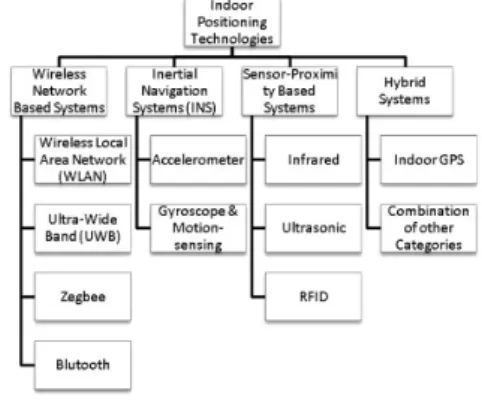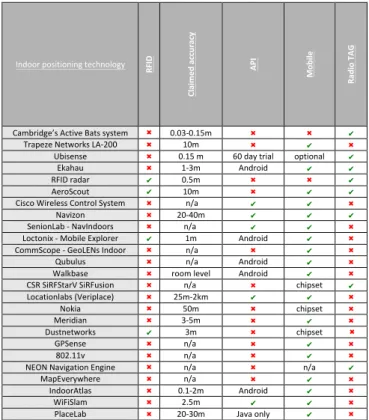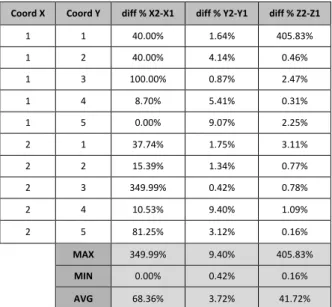Figure 1. Taxonomy of indoor positioning technologies, Soucre:
Saiedeh N. Razavi, Osama Moselhi, “GPS-less indoor construction location sensing” in Automation in Construction, Vol. 28, Dec.
2012, pp. 128–136
A comparative analysis of standardized technologies for providing indoor geolocation
functionality
Ferenc Brachmann
University of Pécs Faculty if Sciences, Pécs, Hungary brachmann.ferenc@ttk.pte.hu
Abstract—Indoor geolocation technologies are being developed at an ever increasing rate. The ability to provide the function of geolocation of a mobile device without the need for external hardware has been a great challenge to researchers and technology companies alike. The challenge stems from the fact that none of the available technologies within mobile handsets meet the performance and functional requirements to enable the trivial development of and indoor geolocation technology. Research is required to evaluate the performance of several technological options and the possible combination of radio and non-radio-based technologies to provide the desired functionality. In this paper, we present measurement results to demonstrate the variance of accuracy of magnetometer measurements within a popular mobile handset to question the possibility of developing an indoor geolocation solution relying solely on this technology.
I. BACKGROUND
GPS geolocation technology is the standard for a wide range of location-based services (like car navigation or simple check-in applications) but this technology has one serious drawback, the lack of indoor coverage. This drawback coupled with the lack of consumer-friendly alternatives on the market hamper the development of a wide-range of indoor location-based services that could change the way we work, shop and live our everyday lives.
Although several custom-hardware-based indoor geolocation solutions exist, the functionality to geolocate mobile devices (Smartphones, tablets, laptops) without
the need to attach specialized hardware has only been developed for outside environments (GPS).
Several technologies have been in development to provide the desired functionality in indoor environments with massively differing technological and conceptual backgrounds. Saiedeh [et al., 2012] and Deak [et al., 2012] provide a sufficient background on the problems relatively long past.
II. ANALYSIS
The global indoor geolocation is very underdeveloped.
Market demand is only starting to appear with some building operators especially in commercial real estate market looking for solutions.
The supply side of the market is the main reason for the underdeveloped nature of demand: there are close to 3 dozen players that are claiming to offer solutions, barely a handful of them actually supply the technologies showcased in their marketing materials. Our research activities will show that the functional and performance requirements needed to fulfill the role of user friendly, completely automated indoor geolocation with 1-3m (sub-
Indoor positioning technology
GNSS Ultrasound GSM Bluetooth 802.11 Gyro Compass Accelerometer Barometer
Cambridge’s Active Bats system ✖ ✔ ✖ ✖ ✖ ✖ ✖ ✖ ✖
Trapeze Networks LA-‐200 ✖ ✖ ✖ ✖ n ✖ ✖ ✖ ✖
Ubisense ✖ ✔ ✖ ✖ ✖ ✖ ✖ ✖ ✖
Ekahau ✖ ✖ ✖ ✖ ✔ ✖ ✖ ✖ ✖
RFID radar ✖ ✖ ✖ ✖ ✖ ✖ ✖ ✖ ✖
AeroScout ✔ ✔ ✖ ✖ b ✖ ✖ ✖ ✖
Cisco Wireless Control System ✖ ✖ ✖ ✖ ✔ ✖ ✖ ✖ ✖
Navizon ✔ ✖ ✔ ✖ ✔ ✖ ✖ ✖ ✖
SenionLab -‐ NavIndoors ✖ ✖ ✖ ✖ ✔ ✖ ✖ ✖ ✖
Loctonix -‐ Mobile Explorer ✔ ✖ ✔ ✖ ✖ ✔ ✔ ✖ ✔ CommScope -‐ GeoLENs Indoor ✖ ✖ ✔ ✖ ✔ ✖ ✖ ✖ ✖
Qubulus ✖ ✖ ✖ ✖ ✔ ✖ ✖ ✖ ✖
Walkbase ✖ ✖ ✖ ✖ ✔ ✖ ✖ ✖ ✖
CSR SiRFStarV SiRFusion ✔ ✖ ✖ ✖ ✔ ✖ ✔ ✔ ✔
Locationlabs (Veriplace) ✔ ✖ ✔ ✖ ✖ ✖ ✖ ✖ ✖
Nokia ✖ ✖ ✖ ✖ ✖ ✖ ✖ ✖ ✖
Meridian ✖ ✖ ✖ ✖ ✔ ✖ ✖ ✖ ✖
Dustnetworks ✖ ✖ ✖ ✖ ✔ ✖ ✖ ✖ ✖
GPSense ✔ ✖ ✖ ✖ ✖ ✔ ✔ ✔ ✖
802.11v ✖ ✖ ✖ ✖ ✔ ✖ ✖ ✖ ✖
NEON Navigation Engine ✔ ✖ ✖ ✖ ✖ ✔ ✖ ✔ ✔
MapEverywhere ✖ ✖ ✖ ✖ ✖ ✖ ✖ ✖ ✖
IndoorAtlas ✖ ✖ ✖ ✖ ✖ ✖ ✔ ✖ ✖
WiFiSlam ✖ ✖ ✖ ✖ ✔ ✖ ✖ ✖ ✖
PlaceLab ✖ ✖ ✔ ✔ ✔ ✖ ✖ ✖ ✖
Table 1. A functional analysis of indoor geolocation technologies CINTI 2012 • 13th IEEE International Symposium on Computational Intelligence and Informatics • 20–22 November, 2012 • Budapest, Hungary
127 978-1-4673-5206-2/12/$31.00 ©2012 IEEE
Figure 3. Screenshot of the magnetometer measurement application Figure 2. Sample plots of h
!
WiFi Gaussian weighted interpolation ofWiFi points, evaluated over a grid with scale parameter = 2:2 m.
Source: J. Huang, D.Millman, M. Quigley, D. Stavens, S. Thrun, A.
Aggarwal: Efficient, Generalized Indoor WiFi GraphSLAM
room-level) accuracy can not be met with any currently available technology.
The subjects of the current analysis can be grouped in the following clusters:
A. RFID or Mixed technologies relying on RFID (RFID radar, AeroScout, Loctonix - Mobile Explorer Platform, Dustnetworks)
These technologies require some form of RFID tag to be carried around by the user. This fact makes it impossible to create a seamless, user-friendly indoor geolocation service available to the masses. This drawback coupled with the fact that the typical range of passive RFID tags would require sensor networks that are way to expensive and complicated to even be economically feasible makes these technologies obsolete.
B. Wi-Fi (802.11) or Bluetooth-based technologies (Navizon, Navindoors, GeoLENs Indoor, Qubulus, Walkbase, CSR SiRFStarV SiRFusion)
Although several research results on the matter of WiFi-based indoor geolocation systems date back to 2008 (Jaegeol, et al. 2008 shall be noted) the industrial use of this theoretical approach has not blossomed in the pest years.
These technologies present the only currently available technologies actually available in the market. The high availability of standardized radio technologies in
smartphones made WiFi and Bluetooth the prime target of new entries in the global market in the last 2 years.
These technologies all suffer from the same functional and performance challenges:
• Lack of Apple iOS support
Roughly 30% of the global smartphone market (in developed areas) and close to 90% of the global tablet market is held by Apple. Apple’s iOS platform poses very strict guidelines for accepting 3rd party applications into its AppStore. These include no direct requests to most hardware components of the device. This fact makes it practically impossible to create an indoor geolocation solution based on WiFi (or any other radio sensor inside the device) because there is no way to get a reading of the signal strength of surrounding devices. This practice of Apple is likely continuing to the future as we’ve had several discussions with Apple’s staff over this particular matter.
• Inaccurate measurement due to inhomogeneous hardware on the client’s side
The open nature of the Android platform presents another challenge to developers. This platform is capable of running on several hundred different devices all with different components. This fact makes signal strength
mapping very inaccurate, containing a high degree if variance. Different hardware components and configurations will show slightly different readings that make automated, easy to use indoor geolocation a great challenge.
C. Alternate players: Gyro/Compass or accelerometer- focused technologies (Loctonix - Mobile Explorer Platform, CSR SiRFStarV SiRFusion, NEON Navigation Engine)
These technologies are focusing on using non-radio sensors inside mobile devices to measure indoor location.
These include the accelerometer measurements and/or compass or magnetometer inside mobile devices. These
Indoor positioning technology RFID Claimed accuracy API Mobile Radio TAG
Cambridge’s Active Bats system ✖ 0.03-‐0.15m ✖ ✖ ✔
Trapeze Networks LA-‐200 ✖ 10m ✖ ✔ ✖
Ubisense ✖ 0.15 m 60 day trial optional ✔
Ekahau ✖ 1-‐3m Android ✔ ✔
RFID radar ✔ 0.5m ✖ ✖ ✔
AeroScout ✔ 10m ✖ ✔ ✔
Cisco Wireless Control System ✖ n/a ✔ ✔ ✖
Navizon ✖ 20-‐40m ✔ ✔ ✔
SenionLab -‐ NavIndoors ✖ n/a ✔ ✔ ✖
Loctonix -‐ Mobile Explorer ✔ 1m Android ✔ ✖
CommScope -‐ GeoLENs Indoor ✖ n/a ✖ ✔ ✖
Qubulus ✖ n/a Android ✔ ✖
Walkbase ✖ room level Android ✔ ✖
CSR SiRFStarV SiRFusion ✖ n/a ✖ chipset ✔
Locationlabs (Veriplace) ✖ 25m-‐2km ✔ ✔ ✖
Nokia ✖ 50m ✖ chipset ✖
Meridian ✖ 3-‐5m ✖ ✔ ✖
Dustnetworks ✔ 3m ✖ chipset ✖
GPSense ✖ n/a ✖ ✔ ✖
802.11v ✖ n/a ✖ ✔ ✖
NEON Navigation Engine ✖ n/a ✖ n/a ✔
MapEverywhere ✖ n/a ✖ ✔ ✖
IndoorAtlas ✖ 0.1-‐2m Android ✔ ✖
WiFiSlam ✖ 2.5m ✔ ✔ ✖
PlaceLab ✖ 20-‐30m Java only ✔ ✖
Table 2. A functional analysis of indoor geolocation technologies F. Brachmann • A Comparative Analysis of Standardized Technologies for Providing Indoor Geolocation Functionality
128
sensors offer different approach to the problem. As a fresh paper in the subject confirms, using single sensor has rapidly deteriorating accuracy over time. Combining several sensors can limit this to around 20 meters (in both axes meaning 400m2) that renders this approach very inaccurate. Using landmarks (objects to be recognized by the smartphone through the camera) to further increase precision will require user interaction that is very much against the requirement of user friendliness.
There are a long list of articles of research elaborating the use of the Earth’s magnetic characteristics for navigational purposes by birds and other creatures (for example Boles et al. 2003 or Wiltschko and Wiltschko, 1972 or Maugh, 1982), there have not been any attempts so far to use this characteristic of the ground to provide the functionality of indoor geolocation of mobile handsets.
An interesting revelation in this category is headed by IndoorAtlas, a spin-off of the University of Oulu, Finland. This company promises sup-meter precision based on only magnetometer measurements. Although several marketing materials are already circulated, no real-life demonstration is or possibility to try the technology is available.
To test the effectiveness and accuracy of the proposed approach, we’ve developed our own magnetometer measurement app in several platforms to test the concept.
To demonstrate the extremely high variance in measurement of a single point we present the following dataset. We have measured the magnetometer readings on an iPhone 4 in 10 different physical coordinates in a 2x5 tile mesh.
Results show a 10-350% variance in measured values due to several factors. The high degree of magnetic noise coupled with the uneven nature of the Earth’s magnetic sphere makes indoor geolocation using magnetometer readings a very tough challenge. Based on the results our conclusion is that controlling the high degree of variance in readings is too much of a challenge to make this approach a very-very challenging one. Further analysis shows that the measurement difference between the coordinates only shows significant change in the X and Z
coordinates that have way the highest measurement variance.
We strongly believe that the magnetic characteristics of
the Earth measureable by relatively inexpensive handheld consumer devices in a relatively short timeframe do not represent sufficient information for accurate indoor geolocation.
It is safe to say that using these non-radio technologies for indoor geolocation are very far away from the functional and performance requirements of today.
Advances in sensor accuracy are possible but handset makers are not motivated to increase costs so with the open nature of the Android Platform and the closed nature of the iOS platform advances are projected to be slow and marginal. Our estimates show no significant
X Y X1 Y1 Z1 X2 Y2 Z2
1 1 4.44 -‐45.55 120.41 2.22 -‐44.44 -‐121.57
1 2 2.78 -‐39.44 -‐126.20 1.39 -‐41.94 -‐125.33 1 3 0.56 -‐42.77 -‐126.78 2.22 -‐42.22 -‐122.15 1 4 4.44 -‐39.99 -‐125.04 3.89 -‐43.33 -‐124.46 1 5 2.50 -‐46.94 -‐118.97 2.50 -‐40.83 -‐123.02 2 1 5.83 -‐41.94 -‐125.91 3.06 -‐43.05 -‐120.12 2 2 1.11 -‐41.66 -‐125.04 1.39 -‐40.83 -‐126.49 2 3 0.28 -‐44.16 -‐123.02 -‐1.67 -‐43.88 -‐124.46 2 4 1.67 -‐43.33 -‐123.31 1.94 -‐37.49 -‐125.33 2 5 4.17 -‐40.83 -‐123.02 0.56 -‐42.77 -‐122.73 Table 3. Magnetometer measurements in 10 different physical
locations
Coord X Coord Y diff % X2-‐X1 diff % Y2-‐Y1 diff % Z2-‐Z1
1 1 40.00% 1.64% 405.83%
1 2 40.00% 4.14% 0.46%
1 3 100.00% 0.87% 2.47%
1 4 8.70% 5.41% 0.31%
1 5 0.00% 9.07% 2.25%
2 1 37.74% 1.75% 3.11%
2 2 15.39% 1.34% 0.77%
2 3 349.99% 0.42% 0.78%
2 4 10.53% 9.40% 1.09%
2 5 81.25% 3.12% 0.16%
MAX 349.99% 9.40% 405.83%
MIN 0.00% 0.42% 0.16%
AVG 68.36% 3.72% 41.72%
Table 4. Statistical descriptive values of the measurements
CoordX CoordY AVG X AVG Y AVG Z
1 1 3.33 -‐44.99 -‐0.58
1 2 2.08 -‐40.69 -‐125.77
1 3 1.39 -‐42.49 -‐124.46
1 4 4.17 -‐41.66 -‐124.75
1 5 2.50 -‐43.88 -‐120.99
2 1 4.44 -‐42.49 -‐123.02
2 2 1.25 -‐41.24 -‐125.77
2 3 -‐0.69 -‐44.02 -‐123.74
2 4 1.81 -‐40.41 -‐124.32
2 5 2.36 -‐41.80 -‐122.87
STDEV 1.50 1.52 39.04
AVG 2.26 -‐42.37 -‐111.63
% diff 66.46% -‐3.58% -‐34.98%
Table 5. Average reading with standard deviation
CINTI 2012 • 13th IEEE International Symposium on Computational Intelligence and Informatics • 20–22 November, 2012 • Budapest, Hungary
129
improvement in accuracy and usability in this segment within 3-5 years.
D. Hardware-based solutions (Nokia, In-Location Alliance)
Nokia has always been developing their own indoor positioning technologies, but in the last years, no feasible technologies have come out of the laboratory. A little over a moth ago, the industry was rocked by a formation of a new alliance of some big names in the handset market with some technology providers.
“The In-Location Alliance was launched by 22 companies across industries to drive innovation and market adoption of high accuracy indoor positioning and related services. The Alliance will focus on creating solutions offering high accuracy, low power consumption, mobility, implementability and usability. It will create an ecosystem that stimulates innovation, enhances service delivery, and accelerates the adoption of solutions and technologies that optimize the mobile experience.” (Nokia, 2012)
The founding members of the alliance are: Broadcom, CSR, Dialog Semiconductor, Eptisa, Geomobile, Genasys, Indra, Insiteo, Nokia, Nomadic Solutions, Nordic Semiconductor, Nordic Technology Group, NowOn, Primax Electronics, Qualcomm, RapidBlue Solutions, Samsung Electronics, Seolane Innovation, Sony Mobile Communications, TamperSeal AB, Team Action Zone and Visioglobe.
These hardware-based approaches will most likely suffer from adaptation needs. Any solution offered has to be available to most smartphone users instantly without and hardware upgrade. Apple’s reluctance to include NFC within the iPhone 5 clearly shows that their closed mentality is only open to their own innovations. Because of the fragmented nature of the global handset market any hardware-based solution has a 3-5 year acceptance rate at best. None of the work-in-progress developments from Qualcomm of Broadcom show significant signs of improvement.
We can conclude that hardware-based solutions are 2-3 years away and will take years for market adaptation mainly due to the fragmented nature of the global handset market and the stiff competition between mobile platform vendors.
III. SUMMARY,FUTURE RESEARCH
Based on the analysis conducted and the measurement activities we can conclude the following:
1. In the current global indoor geolocation market there are no technologies available that meet the functional and performance requirements proposed.
2. The technology proposed by IndoorAtlas to use the Earth’s magnetic characteristics to provide the functionality of indoor geolocation is a
challenging task. The degree of variance within measured magnetometer results proposes great challenges to developing a solution within this technological framework.
In conclusion, the following areas of research are defined:
1. Further research is needed in the area of hybrid indoor positioning systems. The trade- offs and the synergies between the different underlying technologies can be beneficial.
2. Research of ultrasonic sound sensing for the function of indoor geolocation should be further elaborated.
3. The relation between indoor and outdoor geolocation technologies has to be elaborated in order to create a theoretical framework to enable the common analysis of both.
ACKNOWLEDGMENT
This research was enabled by the financial support from the TÁMOP 4.2.1. B-10/2KONV-2010-0002 project named: “Increasing the competitiveness of the universities of the South Transdanubian region” supported by the European Social Fund.
REFERENCES
[1] Saiedeh N. Razavi, Osama Moselhi, “GPS-less indoor construction location sensing” in Automation in Construction, Vol. 28, pp. 128–136, Dec. 2012
[2] Gabriel Deak, Kevin Curran, Joan Condell, “A survey of active and passive indoor localisation systems”, in Computer Communications, Vol. 35, I. 16, pp. 1939–1954, 15 September 2012
[3] Huang, J., Millman, D. ; Quigley, M. ; Stavens, D. ; Thrun, S. ; Aggarwal, A.: “Efficient, Generalized Indoor WiFi GraphSLAM”
in proc. Robotics and Automation (ICRA), 2011 IEEE International Conference on Robotics and Automation, pp. 1038- 1043
[4] L. C. Boles and K. J. Lohmann. True navigation and magnetic maps in spiny lobsters. Nature, 421:60–63, 2003.
[5] W.Wiltschko and R.Wiltschko. Magnetic compass of european robins. Science, 176:62–64, 1972.
[6] T.H. Maugh. Magnetic navigation an attractive possibility.
Science, 215:1492–1493, 1982.
[7] H. Mouritsen, G. Feenders, M. Liedvogel, and W. Kropp.
Migratory birds use head scans to detect the direction of the earths magnetic field. Cur. Biol., 9:1946–1949, 2004.
[8] C. V. Mora, M. Davison, J. M. Wild, and M. M. Walker.
Magnetoreception and its trigeminal mediation in the homing pigeon. Nature, 432:508–511, 2004.
[9] By Nokia - Press Release, “Accurate Mobile Indoor Positioning Industry Alliance, called In-Location, to promote deployment of location-based indoor services and solutions”, Internet:
http://press.nokia.com/2012/08/23/accurate-mobile-indoor- positioning-industry-alliance-called-in-location-to-promote- deployment-of-location-based-indoor-services-and-solutions/
August 23, 2012 [October 15, 2012]
[10] J. Yim, C. Park, J. Joo, S. Jeong, “Extended Kalman Filter for wireless LAN based indoor positioning”, Decision Support Systems, 45, pp. 960–971, 2008
F. Brachmann • A Comparative Analysis of Standardized Technologies for Providing Indoor Geolocation Functionality
130


